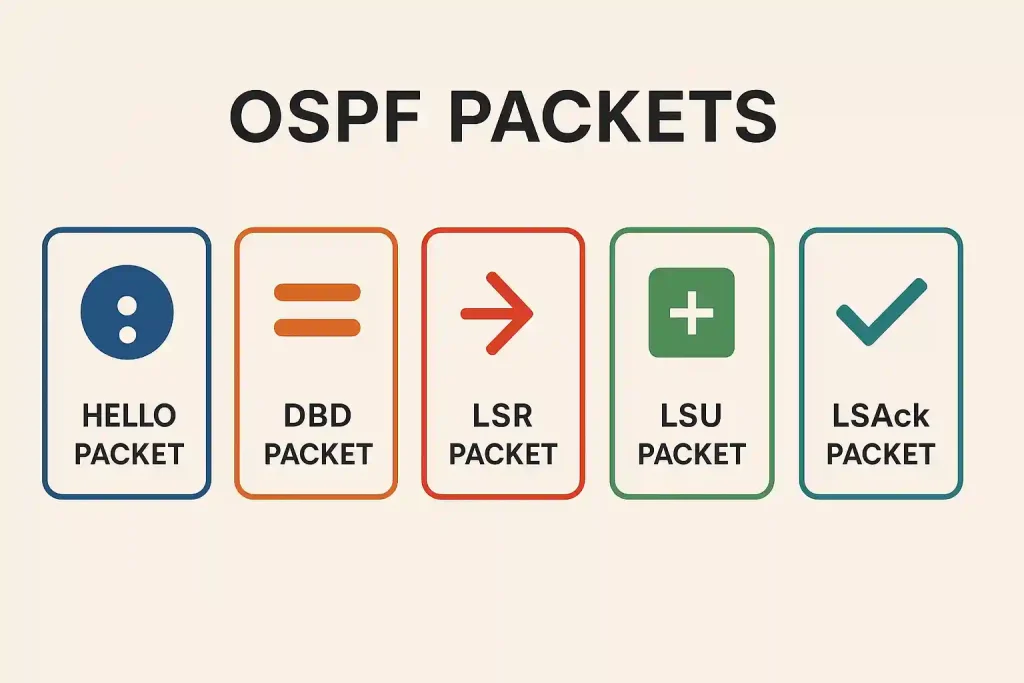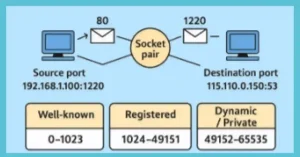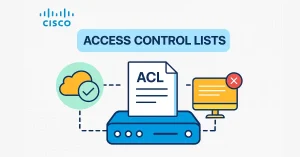Open Shortest Path First (OSPF) is a powerful link-state routing protocol widely used in enterprise networks and a key topic for CCNA and CCNP certifications. OSPF relies on five distinct packet types to establish neighbor adjacencies, exchange routing information, and maintain a consistent Link-State Database (LSDB) across routers in an area. Understanding these OSPF packets—Hello, Database Description (DBD), Link-State Request (LSR), Link-State Update (LSU), and Link-State Acknowledgment (LSAck)—is crucial for mastering OSPF operations, troubleshooting network issues, and excelling in Cisco exams. This article dives into each packet type, its roles, and practical insights to help networking students and professionals succeed.
OSPF Packet Header Structure
All OSPF packets share a standard 24-byte header that contains critical information for packet processing. Understanding the header is essential for troubleshooting and analyzing OSPF behavior using tools like Wireshark. Below is a breakdown of the OSPF header fields:
| Field | Length | Description |
|---|---|---|
| Version | 1 byte | Specifies the OSPF version (e.g., 2 for IPv4, 3 for IPv6). |
| Type | 1 byte | Indicates the packet type (1: Hello, 2: DBD, 3: LSR, 4: LSU, 5: LSAck). |
| Packet Length | 2 bytes | Total length of the packet, including the header. |
| Router ID | 4 bytes | Unique identifier of the sending router. |
| Area ID | 4 bytes | Identifier of the OSPF area the packet belongs to. |
| Checksum | 2 bytes | Ensures packet integrity. |
| Authentication Type | 2 bytes | Specifies the authentication method (0: None, 1: Cleartext, 2: Cryptographic). |
| Authentication Data | 8 bytes | Contains authentication information (e.g., password or hash). |
This header ensures OSPF packets are correctly identified, processed, and authenticated by receiving routers.
Hello Packet in OSPF
The Hello packet (Type 1) is fundamental to OSPF’s operation, enabling routers to discover neighbors and form adjacencies. Sent periodically (typically every 10 seconds on broadcast networks), Hello packets are multicast to 224.0.0.5 (AllSPFRouters) to dynamically identify neighboring routers. They play a critical role in the OSPF state machine, transitioning routers from the Down state to the Init, 2-Way, and eventually Full adjacency states.
Key Fields in Hello Packets
- Network Mask: Ensures routers are on the same subnet.
- Hello Interval: Time between Hello packets (must match for adjacency).
- Dead Interval: Time to wait before declaring a neighbor down (typically 4x Hello Interval).
- Designated Router (DR): IP address of the DR, if applicable.
- Backup Designated Router (BDR): IP address of the BDR, if applicable.
- Neighbor List: Lists neighbors the router has already discovered.
Practical Notes
For CCNA/CCNP students, understanding Hello packets is key to configuring and verifying OSPF neighbors using commands like show ip ospf neighbor.
Mismatched Hello or Dead Intervals prevent adjacency formation, a common troubleshooting issue.
Link-State Update (LSU) packet
This packet is used to reply to a link-state request (LSR) packet. The link-state update (LSU) contains seven further types of packets.
The Link-State Update (LSU) packet (Type 4) carries one or more Link-State Advertisements (LSAs) to distribute routing information. LSAs are the building blocks of the OSPF Link-State Database (LSDB). There are seven primary LSA types used in OSPF for IPv4, each serving a specific purpose:
| LSA Type | Name | Description |
|---|---|---|
| 1 | Router LSA | Describes a router’s links and their states within an area. |
| 2 | Network LSA | Generated by the DR, describes the set of routers attached to a network. |
| 3 | Summary LSA (Network) | Advertises inter-area routes (e.g., from ABRs). |
| 4 | Summary LSA (ASBR) | Advertises the location of an ASBR (Autonomous System Boundary Router). |
| 5 | AS External LSA | Advertises routes external to the OSPF domain (e.g., redistributed routes). |
| 7 | NSSA External LSA | Used in Not-So-Stubby Areas (NSSAs) for external routes. |
| 11 | Opaque LSA (Area-Local Scope) | Used for applications like traffic engineering (less common in CCNA/CCNP). |
Practical Notes
LSUs are sent in response to LSRs or when topology changes occur (e.g., link failure).
For CCNP students, understanding LSA types is critical for configuring OSPF areas and troubleshooting LSDB inconsistencies.
Database Description (DBD) packet
The Database Description (DBD) packet (Type 2) contains a summary of the sending router’s Link-State Database (LSDB). Receiving routers compare this summary with their own LSDB to identify missing or outdated entries. DBD packets are exchanged during the Exchange state of OSPF adjacency formation to ensure all routers in an area maintain an identical LSDB, which is essential for constructing an accurate Shortest Path First (SPF) tree.
Practical Notes
For CCNA students, focus on the role of DBD in synchronizing LSDBs during adjacency formation.
DBD packets are sent as a sequence, with flags (e.g., Master/Slave, More) to manage the exchange process.
Link-State Request (LSR) packet
When receiving routers read the DBD, the receiving router can request more information about any entry in the DBD, sending an LSR packet. The router uses LSR packets for requesting the pieces of the neighbour’s database that are more up-to-date and complete. The router can also send multiple Link State Request packets.
Link-State Acknowledgment (LSAck) packet
When the router receives an LSU packet, it sends an LSAck packet to the sender router to confirm receipt of the LSU packet. The LSAck data field is empty. A Single State Acknowledgement packet can acknowledge multiple link-state advertisements.
FAQs
What is the purpose of OSPF Hello packets?
Hello packets discover and maintain neighbor adjacencies by exchanging parameters like Router ID, Hello Interval, and Dead Interval. Sent every 10 seconds, they ensure routers are reachable, which is critical for OSPF stability.
How does the DBD packet help in OSPF operations?
DBD packets summarize the router’s LSDB, enabling neighbors to identify missing or outdated LSAs during adjacency formation, ensuring a consistent database for SPF calculations.
What is the role of LSU and LSR packets in OSPF?
LSR packets request specific LSAs identified in DBDs, while LSU packets deliver these LSAs to synchronize the LSDB, ensuring all routers have updated topology information.
Why is the LSAck packet important in OSPF?
LSAck packets confirm receipt of LSU packets, preventing retransmissions and ensuring reliable LSDB updates. A single LSAck can acknowledge multiple LSAs, reducing overhead.





